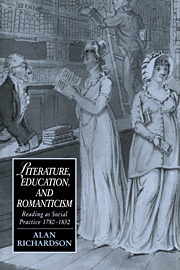5 - The pursuit of knowledge under difficulties
Published online by Cambridge University Press: 08 February 2010
Summary
In her Letters to a Young Lady, after advice on dress, deportment, reading, and religious conformity, Jane West includes a brief section on writing tracts and stories for the “instruction of the lower orders” (433–35). For West, educating the poor through supporting Sunday Schools and handing out “cheap well principled tracts” (451) makes part of the middle-class woman's matriarchal cultural role – the section on the duty to “Servants and Inferiors” directly follows that “On the Duty of Mothers.” While attesting to the considerable reformist energies of prominent women like West and Hannah More, this maternal approach to educating lower-class adults (along with their children) also bears witness to the pervasive infantilization of “inferiors” within the social discourses of the Romantic era. It is not surprising to find that the tradition of “popular” fiction written from above (as opposed to genuinely popular forms like chapbooks, street ballads, and murder sheets) is initially dominated by women writers also active in literary and educational ventures aimed at children: Trimmer, whose Servant's Friend (1786) and Family Magazine (1788–89) were among the earliest “improving” works aimed at “cottagers and servants”; More, who helped codify the genre with the Cheap Repository Tracts; and Sherwood, who described her novella Susan Grey (1802) as the first popular narrative to combine “correct writing” with a religious message (Life 206).
These works all adopt the simple and entertaining approach which West recommends to her female reader (454). They also proved (with the exception of Susan Grey, which found a place in the growing market for cheap religious works) singularly ineffective at reaching their audience.
- Type
- Chapter
- Information
- Literature, Education, and RomanticismReading as Social Practice, 1780–1832, pp. 213 - 259Publisher: Cambridge University PressPrint publication year: 1994



